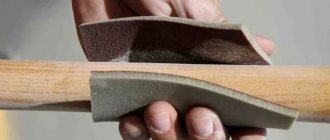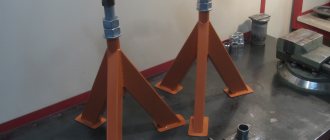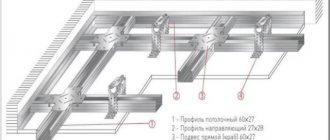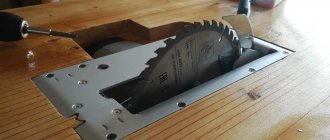How to lift a beam alone, without a hoist and a crane
When building houses and commercial buildings, you often have to do the work alone, for one reason or another.
Yes, unfortunately, many works are carried out in order to save money, and gone are the days when houses and households were raised by the whole family. Therefore, the question arises, how to cope with some difficult installation work alone? Yes, you can lift a heavy beam alone, using the simplest tools. To do this, take two guide rails, logs, thick boards of suitable cross-section, which are installed from the bottom up, from the location of the beam to the place where it is laid. Along the edges of the beam being lifted, strong ropes, slings or cables are attached, which on one side are attached to strong elements at the top to the wall of the building or to the ends of the guide logs.
And the other ends of the ropes are wound and secured to the ends of the beam being lifted. A handle in the form of a gate, about 120 cm long, is attached to one of the ends. After this, you begin to twist the installed gate with the log to the right and it, fixed on the ropes, rises along the guides, winding the rope on both sides. Of course, it is easier to rotate a heavy log than to lift it completely. After it is lifted, all that remains is to free it from the ropes and lay it at the installation site.
There is a simpler option, using the same guides, but without ropes. Stops are attached to the guides at a certain pitch. For square logs, these can be nails or screws, for round ones, screwed pieces of bars. They are needed to prevent the log from rolling away. The log is lifted one by one and fixed on the stops, one space at a time, first on one side, then on the other. Thus, you lift half the weight of the beam and gradually raise its top.
In the first and second options, at the top of the rise you will need a ladder or scaffolding if the building is high.
Horizontal boom lift
A crane with a horizontal boom is manufactured as follows. A frame is welded from a pipe or angle crosswise on wheels, on which in the rear part it is necessary to make a place for a counterweight to avoid the loss of balance of the crane during operation and its fall. Wheels are installed on it for easier movement. The larger the frame area, the more stable the crane.
Stops are installed on its edges near the wheels to prevent movement during operation.
After manufacturing the frame, a mast is installed vertically in its center, on which the boom is fixed. The fastening must be strong, it must rotate around its axis.
An additional stop with a handle is attached horizontally from the vertical mast to rotate it. A place for attaching a manual or electric winch is installed on it. Another mast is additionally mounted vertically to the stop, which is attached from above to the boom to provide greater stability and strengthen its fixation.
At the top, a boom is attached to both masts, equipped at both ends with rollers for the cable, so that the central vertical support rests on the center of the boom, and the second, additional one, exactly in the center between the first mast and the rear edge of the boom.
A winch is placed on a horizontal support fixed to the second vertical mast.
Its cable first passes through the roller on the back side of the boom, then through the front roller with a hook at the end. The entire crane structure is assembled with utmost strength and can be disassembled for ease of transportation. A gripper is installed that lifts the blocks.
Devices for lifting logs, beams, and other heavy objects
Once upon a time, the working option for building my house was timber. And calculating the savings, I worked on various options, including how to assemble a wooden house alone. Of course, this is not very convenient, but the budget was very limited. I abandoned the “kidney” technology, so I thought about a lifting device and looked for suitable solutions around and on the Internet.
One person can lift logs weighing 100-150 kg using simple tools. And if there are forest trees on the site and a crane is not suitable, it is difficult to do without such devices.
I saved some photographs in my construction folder, but unfortunately there was no information left about the sources. I want to share them here, maybe you will find them useful and relevant, or just give you the right idea. You can make them yourself - from corrugated pipe, boards, a block or even a bicycle wheel, and preferably some kind of motor to reduce manual labor..
For example, this log house was assembled entirely by a man alone. At the same time, he did not move the crane, he stood in one place all the time.
Drawings of another device, light and mobile:
And here is their embodiment in matter :)
The same thing, but when, in addition to “putting it on” on the wall, there is also the opportunity to install it on a plane:
An original solution made from improvised means, along which the log “rides” to the top like on a bicycle :)
Lifting a log using an ochapa
Ochap has the shape of a well crane, which was used in ancient times. It is installed next to the house being built, and it works like a crane - simply and easily:
- Hook the log on a rope attached to the ochapa.
- Raise it to the required height using the effort of your hands, body and counterweight on the ochap.
- Fix the second end of the rope below, under the counterweight on a specially equipped support.
- Having swung the suspended log, determine its place on the log house and lower it there. At the same time, the second worker must release the end of the rope on the counterweight.
Tools for builders
Simple devices at a construction site
Any construction site cannot do without effective and simple devices to facilitate labor and increase the speed and quality of the object being built. Today in this article I will talk about some of them, the simplest and most effective.
The easiest way to climb along guides, two ropes and fixed guides are enough for it.
Refilling chain hoists
Reeving is a procedure for changing the location of pulleys and the distance between them. The purpose of this operation is to regulate the speed and height of lifting loads in accordance with a certain pattern of cable passage through the blocks of the lifting mechanism. There are the following types of reserve:
- One-time. 1 rope is attached to the hook, which is passed through all the fixed blocks and wound onto the drum.
- Double. The first end of the rope is attached to the head of the crane's rotating element, the second - to the winch. This reeving method can be used on jib-type cranes.
- Quadruple. 2 working branches of the cable are routed through the working boom pulleys. Adjacent pulleys are fastened together using a static block installed on the platform stand. This reeving method is used for heavy-duty applications.
There is also variable reeving. It can be either double or quadruple. The movable rollers are mounted on several movable cages held by a rope. The reeving ratio is changed by lowering the hook suspension onto the support while reeling in the rope.
The most interesting and useful devices for construction
When building any object, be it a house or something else that requires lifting heavy objects to a height, you need to go in two ways.
The first and easiest way is to hire people to lift heavy materials such as mortar, concrete or something similar.
Second, make a lifting mechanism capable of lifting heavy loads.
This device can replace at least three people and it is made of an aluminum ladder and an electric hoist.
Such a lift is capable of lifting three buckets of concrete and can be used alone. It’s not difficult to make a welded frame on bearings, and anyone with a little knowledge of electric welding can easily attach an electric hoist to the top of a ladder.
If you attach the electric hoist as shown in the photo to a well-reinforced beam, then you will get a very convenient device that can easily replace a crane.
This simple device will speed up your work on grinding grooves when building from round timber. Using the same principle, you can make other devices for carpentry work.
With the help of such a simple device, you can not only break walls with virtually no noise, but also press metal parts during installation and hold together floor boards during installation.
A very convenient device, especially in the manufacture of fencing and other work involving a large amount of work with bent wire and fittings.
I also have experience working with almost the same device when making fences, and I liked that the speed of work increases significantly.
Making such a device for cleaning walls from paint will not take much time; for this you need a welding machine, an old drill, and by welding a metal plate to the drill, you can increase the speed of cleaning the walls using a hammer drill.
Using an attachment that you can buy in a store today and a construction vacuum cleaner, you can remove paint from the wall with virtually no dust.
Homemade crane for building a house
Many people believe that building a house from 6-meter timber alone is a fantasy task. Nevertheless, it is quite possible to do this, but you will have to use an assistant crane, which is quite possible to build yourself.
Since the wooden beam is quite bulky and heavy, it will be quite difficult to lift it yourself. With the help of a crane, in turn, the timber can be placed at the cutting site, and also, with the help of its functions, you can quite successfully lift the sawn timber onto the base of the house.
Any type of scrap metal is suitable for the frame of a homemade crane. At the same time, it can be made from ordinary corners measuring 63x63x5 millimeters.
A five-meter pipe with a diameter of 50 millimeters was used as an arrow; also, the design feature implies that in the future it will be possible to extend the arrow by several meters. This design is reinforced with metal corners 30x30x3.
The maximum weight lifted by the crane is 150 kilograms. However, the design feature of this crane allows it to lift loads weighing half a ton, but for this it will be necessary to increase the multiplicity of the pulleys.
The principle of operation of the pulley is similar to the operating features of the gearbox: to achieve greater power, it is necessary to provide the appropriate length of the rope, which, accordingly, will need much more. As a result, the speed of lifting the load will slow down, but the crane will be able to lift much more.
One of the main characteristics of the gearbox is the gear ratio; the pulley, in turn, must have a multiplicity - the ratio of the number of “rings” on the cable with those running off the drum. Based on this, in the case when 5 turns are wound on a homemade crane, the pulley is fivefold. In other words, lifting a half-ton load requires the same force as lifting a 100-kilogram load.
What is special about a homemade lifting mechanism?
It is worth noting that the manufacture of all components and mechanisms of a homemade assistant crane is a labor-intensive and tedious process, requiring a huge amount of time. Thus, it will take at least a week to manufacture all the components of the faucet, and it will take another two to three days to assemble the finished device and calibrate it. A six-fold pulley was used as a rotation drive, and the boom lift drive, in turn, was represented by a double mechanical pulley.
Specifically in this device, the rotating platform is made of two faceplates, and the crane itself was assembled from scrap materials, so it is not surprising that its axis is 30 mm. a bolt made of steel that does not have high strength. This decision is due to the fact that high-strength steel is practically impossible to weld: if the tensile strength is exceeded, such a bolt immediately bursts, it can neither be stretched nor bent. It is advisable to lubricate the components of a homemade faucet with a small amount of lithol. To reduce the weight of the counterweight, 2-meter support legs are installed in the crane.
When calculating the components in the manufacture of this device, it is necessary to take into account that with the average radius of the part responsible for the rotation, as well as the distance to the counterweight with the specified mass, a tensile load will act on the main bolt (which, naturally, will be much greater during operation). Before using the crane, you must carefully check the stability indicators.
Blocks for the lifting mechanism can be made from two large and one small washers. Such blocks will be stable. It is extremely important that the cable has the necessary flexibility, or that the blocks themselves have a diameter corresponding to the rope, because when lifting the boom without a load, the rope can fly out of the block, which will be very unpleasant.
A thick cord with a diameter of 15 mm was used as a cable. It is planned that in case of extension, a more flexible 5 mm one will be installed on the tap. cable with a working load of 150 and a breaking load of 850 kg. Such a crane allows you to build a log house almost single-handedly, as well as do a huge amount of other construction work.
How to make useful mechanisms and tools for construction with your own hands
It doesn’t matter whether you’re building your dream home or renovating an old country house, you can’t do without reliable tools and construction equipment. Almost any device today can be bought in a store, but purchases are not always pleasing with quality and even less often with prices. Our forum members know how to reduce the burden on the family budget and offer recipes for proven mechanisms and tools for construction, made with their own hands.
More modern lifting of logs - with a winch
The method requires a handmade or store-bought winch, which can also be borrowed from neighbors or rented. So, a step-by-step description:
- Place the winch at the top and, lowering the cable down, secure it on both sides of the log, so that the branching of the cable to the log is V-shaped.
- Rotate the winch handle, as if pulling a bucket of water from a well, raise the log to the required height.
- Place the log in place and unhook the cable. Work progresses faster if the winch is equipped with an electric motor.
Truck...from the old four
Bring sand, crushed stone, boards, transport a concrete mixer and an old refrigerator... The need to deliver materials and tools during construction arises constantly. FORUMHOUSE member g8o8r8
found a way to save on freight transportation: he converted his old four into a truck!
Budget auto tuning cost the craftsman 3.5 thousand rubles - this was the cost of materials: an iron square, corners, galvanized steel for the loading body. Loading body g8o8r8
made it high to protect it from rainwater: to close the gaps between it and the car body, metal canopies were welded around the perimeter.
The rear side of the body is lifted with a 12-volt electric winch. This is convenient when unloading bulk materials and loading boards, stones, furniture, etc. into the body.
g8o8r8 (FORUMHOUSE Member):
At our metal collection point, they give five thousand rubles for any car. This inspired the idea of using my decommissioned four-wheeler for household needs: bringing earth, peat, stones, sand to the dacha. And if you install a subframe, weld a blade, install chains, you’ll see that you’ll be able to throw snow in the winter.
Manual hoists
- home
- Catalog
- Tali
/
/
- Load capacity from 500 kg. up to 10 tons;
- Lifting height from 3 m or more;
- Extensive selection of modifications;
- High-tech assembly;
- Increased safety margin, ensures minimal maintenance;
- Durable anti-corrosion coating of all parts;
- Compact design for installation in confined spaces;
- Long-lasting bearings in the smooth running roller support;
- Automatic stopper for more precise fixation of the load;
- Special gear design ensures high reliability and efficiency with minimal impact;
- The steel lifting chain is hardened to standard 80;
- Forged 360° swivel hook with safety latch for easy fixation;
- Any chain length;
- The product has a certificate.
| Manual gear hoists with a capacity of 0.5-2 tons. | Manual gear hoists with a capacity of 3-5 tons. |
| G/p, t. | Lifting height, m. | N | IN | A | Traction force, kg. no more | Weight, kg (at N lift, m.) |
| mm, no more | ||||||
| 0,5 | 3-12 | 260 | 131 | 140 | 27 | 8,2 (2,5) |
| 1 | 300 | 151 | 156 | 31,5 | 11,3 (2,5) | |
| 2 | 450 | 183 | 223 | 40 | 21,3 (3,0) | |
| 3 | 550 | 151 | 223 | 47,5 | 21,7 (3,0) | |
| 5 | 700 | 183 | 252 | 48 | 39,7 (3,0) | |
| 10 | 900 | 49,5 | 66,0 (3,0) |
Construction materials lift
Another useful homemade product that will make life at a construction site much easier is a building materials lift. For example, like the one from FORUMHOUSE member Ali-bastr
Having started pouring monolithic walls, the forum member got tired of manually lifting heavy buckets of concrete and made a simple but ingenious design.
The basis of the lift was a metal staircase. To securely fix the ladder on the wall, in a 15×15 Ali-bastre
I drilled holes and put a washer on the back side of the pipe, securing it with a cotter pin. The trolley on which building materials are placed moves up and down on bearings No. 304 using an electric winch. It is located almost parallel, at a slight angle to the stairs, due to which the movement occurs smoothly.
Ali-bastr (FORUMHOUSE member):
It’s not for nothing that they say: laziness is the engine of progress. My lift lifts six buckets of concrete easily!
General information about pulley hoists
A pulley block consists of 2 or more pulleys (blocks) connected using rope ropes or chains:
- Fixed pulley. This block is attached to strong static elements or special equipment. It includes several videos. Each of them carries ropes, metal ropes or iron chains. A fixed pulley distributes pressure between structural elements. The amount of pressure on each rope is determined by the number of rollers.
- Movable pulley. This block is attached to the load and is used to maintain the operation of the lifting mechanism. It is equipped with a hook, carabiner and magnet. A movable pulley, attached to a load, can benefit from effort.
Simple pulleys can consist of 1 pulley and rope. In them, the roller is located above the load: on the ceiling, beam or support. The first end of the rope is connected to the hook and goes down to the load being lifted. A man pulls on the other end of a rope, lifting a heavy object. Complex lifting devices include several simple pulleys and provide greater gains in strength.
The operating principle of pulley blocks is based on the rule of leverage. A rope is thrown over a stationary pulley. The load is raised to a height by applying forces commensurate with the weight of the object being lifted. The length of the rope or chain should be comparable to the height to which the load is lifted. To reduce the amount of effort required, it is necessary that the moving block moves parallel to the load.
There are the following types of pulleys:
- Purpose: power and speed. Power mechanisms are designed to transport heavy objects. They provide gains in strength at the expense of distance and speed. High-speed pulleys allow you to speed up the process of transporting light loads by reducing the applied effort.
- According to the complexity of the scheme. In simple schemes for lifting loads using blocks, all rollers are connected in series using 1 chain or rope. Complex systems are characterized by high performance. The gain in strength comes from fewer blocks.
Pull blocks are used for the following operations:
- For tensioning cables, power lines and suspended structures.
- Together with a winch for pulling out a car or other type of transport stuck in mud or ground.
- For carrying out rigging work when transporting heavy structures.
Various types of cranes, hydraulic and electric drives are equipped with pulleys. They were also used in older elevator prototypes.
Planer for aerated concrete
Aerated concrete is one of the most popular modern materials for the construction of stone houses. The large format of the blocks and the installation technology, which can be easily mastered, allow even novice builders to erect buildings quickly.
But despite all its advantages, aerated concrete has a significant disadvantage - the blocks do not match in size and the need to adjust them to each other. You can use a shop tool for these purposes. But our forum members suggest making a plane for aerated concrete with your own hands. For this you will need: a board 5 cm thick, 3 wood files, universal glue, a door handle.
worodew (FORUMHOUSE Member):
Cut the files in half. We cut grooves in the board to half the thickness of the blade, lubricate the grooves with glue and insert the files. Screw the handle on and you're done.
Manual hoist - how it works and how it works
The design of the manual hoist has two chains of different lengths. One for which you need to pull, the other for lifting the load. The force generated when you pull on a 30-link chain increases your lifting force by 30 times. How does this happen?
The winch itself is suspended above the load that needs to be lifted. The lifting chain is attached to the load. When we pull the hand chain, the large wheel turns and turns the drive shaft, which drives the gears. They, in turn, turn the wheels of the lifting chain, which lifts the load.
To understand how it works, you will have to disassemble the gear hand hoist into pieces. The traction chain is attached to several specially made gaps in the large wheel. As soon as we pull it, it starts to turn it. This large wheel screws tightly onto a friction plate that is attached to the ratchet. Once the large wheel, plate and ratchet begin to turn together, the locking mechanism engages the teeth of the ratchet, preventing the large wheel from spinning back under the weight of the load. And this is just the beginning.
With each transfer of force from wheel to wheel, the force received from the hand pull chain increases and increases all the time. The large wheel is also attached to the drive shaft. As soon as the wheel turns, it drives the shaft. At the other end of the shaft is a small wheel with only five teeth. As it begins to turn, the force applied to the big wheel by the traction chain increases. Thus, it increases in a ratio of 7:5. As a result, this small wheel turns with a force greater than that which presses on the teeth of the wheel. To increase the pressing force, this wheel drives 2 identical wheels at the same time. Thus, the pressing force of the small wheel is distributed over 2 wheels instead of one. The small wheel drives 18 teeth on each of the other wheels. These wheels are special because behind them there is another small wheel with 4 teeth, which in turn also increases the force of impact in the ratio of 18:4.
But that is not all. These small wheels drive another large 19-tooth wheel, which concentrates all the power on several links of the load chain attached to the final sprocket. Thanks to all these wheels, the force increases until it increases 30 times.
Video - how it works
Mobile foam cutting machine
And for those who insulate their house with polystyrene foam, another homemade product from the forum will come in handy - a machine for cutting polystyrene foam, which allows you to cut pieces of the required size simply and quickly, without bothering with a hacksaw and a ruler.
Our forum user Oleg Lvovich
To make a mobile machine, I used a 25x25 mm wooden strip 1.3 meters long, nichrome wire with a cross-section of 1 mm, a spring, two 20x4 mm steel strips, a 220/36V transformer and a 15-20 meter wire.
On FORUMHOUSE, a forum member shares a diagram of a homemade machine:
Unlike stationary cutting machines, this device can be freely moved around scaffolding and cut foam directly on site. At the same time, the sheet can be expanded not only in length, but also in thickness - for this, two profiles are additionally attached to the EPS with nails. According to a forum member, the cost of a mobile machine is 800-1000 rubles, and even with intensive use it will faithfully serve for several construction seasons in a row.
Other examples of machines for cutting foam plastic, including stationary ones, are in this topic.
Grinder cutting machine
Homemade machines for the workshop are always in demand, but the angle grinder (angle grinder), popularly known as the “grinder”, is one of the favorites in the arsenal of any home craftsman. But the instrument requires a very careful attitude, because Any disregard for safety rules when working with an angle grinder can lead to serious injuries. Therefore, when cutting large volumes of metal (when making a fence or cutting reinforcement), many people prefer to work with a metal cutting machine.
You can buy a frame for an angle grinder on the Internet, but to save money, you can make a cutting machine yourself, from an “unnecessary” or “superfluous” grinder, which almost every owner of a country house has. As we'll see, it's good for more than just sharpening garden equipment!
Ivici (FORUMHOUSE User):
I have an angle grinder weighing 5.5 kg. One day I thought about how to make it easier to use. After all, working with it, moving all the time, is inconvenient - your hands get tired quickly. I decided to make a convenient cutting machine from what I had.
Looking ahead, let's say that the machine (more precisely, its second modification) was a success: it cuts smoothly and without distortions.
Ivici
I made it like this - I took a piece of channel No. 6.5 (65 mm wide and 36 mm high). This is the basis of the machine.
A steel strip of 50x5 mm was also required. With its help the angle grinder is secured. A 4x2 cm profile and a three-millimeter piece of steel were also required. A figure eight bolt serves as a turning axis.
In the first version of the machine, a powerful door hinge was used as a rotary axis. But, due to welding, under the influence of high temperature, all the lubricant in the loop burned out, and a backlash appeared in the assembly.
According to the user, the most difficult thing was to accurately mark and drill three holes with a diameter of 14 mm for attaching angle grinders with bolts to the threaded holes intended for installing the side handle.
I also had to work with a round file. A small bore of the holes, due to the backlash, allows you to move the angle grinder a little during the assembly process and accurately install it. After all the parts are ready, the user welded the piece of hardware holding the angle grinder together, assembled the entire structure in rough form, checked all the corners and, making sure that everything was mounted as it should, finally welded the entire structure.
Ivici (FORUMHOUSE User):
The machine is attached to the support table (a piece of slate 1 cm thick) with six self-tapping screws. You can dispense with the return spring, just tighten the axle bolt more tightly. There are no backlashes or distortions when cutting the workpiece. You can also cut at an angle of 45 degrees.
Another homemade machine from an angle grinder was suggested by a portal user with the nickname Bistok
.
As usual, first we understand that we need a homemade tool and some kind of devices, and then the search for the most optimal solution begins. Well, don't buy it!
Bistok (FORUMHOUSE User):
I decided to make the stairs out of metal. To avoid defects, backlashes, and discrepancies, maximum precision is required when cutting metal parts. Therefore, I decided, using an angle grinder as a basis, to make a sawing machine.
Everything that is usually lying around in the home workshop (and it would be a pity to throw it away) of a zealous owner went into action, waiting for its finest hour. As a stand for a Bistok
I used an overlock table.
The swivel unit is made from the hub from the “nine”, because it has a bearing.
As in the option described above, the most difficult thing was to “catch” the right angle between the cutting disc and the stop angle. After all, the accuracy of sawing metal depends on this unit.
The end result is clearly demonstrated by the photo below.
To turn on the Bistok
I made additional wiring - I installed a regular switch and a socket, and an extension cord comes from this switch. You can buy a homemade machine from a craftsman you know, but it’s much better to upgrade to a creator of devices of this level!
Bistok (FORUMHOUSE User):
I got a portable machine. I welded a corner to the handle to get 3 support points for the angle grinder. The fastening with two bolts was adjusted to the location. I work only in safety glasses. I am very pleased with the result of the work done. I didn’t buy anything extra to make the machine. The cut is exactly 90°.
Comfortable grinder
Have you noticed that holding a small grinder by the top handle is convenient, but a large one is not? The big one always tries to escape from your hands when biting into metal. Having such a sad experience, some are generally afraid to use a large grinder. So that the grinder always remains in your hands, forum member chichic
designed a homemade handle for the instrument with a natural grip.
сhichic (FORUMHOUSE Member):
A powerful grinder can break out a cutting disc stuck in the metal, but it always remains in your hands. Proven by ten years of experience and cutting metal up to 14mm.
Budget drilling machines
In addition to cutting machines, various devices for drilling holes in metal are popular. Starting from stationary drilling machines and ending with devices in which a regular drill is fixed, like the “driller” of FORUMHOUSE user with the nickname g8o8r8.
g8o8r8 (FORUMHOUSE User):
While drilling many similar holes in thick metal, in order to relieve my hands, I made a simple device based on a clamp welded to a metal support and a pair of clamps to firmly fix the drill. Now drilling a corner or channel has become much easier.
According to the user, drilling 1 hole with a diameter of 4-5 mm takes no more than 30 seconds. Having decided to repeat such a design, you should remember that the load on the drill increases significantly due to the increase in the volume of work. g8o8r8
I've already rebuilt my drill twice.
Also, the user, based on an electric motor, made a small machine - a “vertical”, for drilling holes with a diameter of up to 4 mm in printed circuit boards.
g8o8r8 (FORUMHOUSE User):
The long spindle compensates for the inaccuracy of the bearing race groove. For amateur use, this machine is quite suitable. Drilling accuracy remains at an acceptable level.
If you do not have a welding machine, you can assemble the device you need on the farm using bolted connections.
DIY cyclone vacuum cleaner
Dust and small debris during construction or major repairs are a real problem, which is difficult and ineffective to combat with a broom and rag. To make the cleaning process easier without spending money on expensive equipment, FORUMHOUSE member zalman3000
I quickly assembled a cyclone for a vacuum cleaner from scrap materials.
Zalman3000 (FORUMHOUSE Member):
I needed: a 20 liter plastic barrel, a 45 degree 40 mm angle, a 90 degree 32 mm angle, an oil filter from Moskvich (it fits tightly at the 32nd angle).
The simple design is attached to the vacuum cleaner, and waste is collected directly into a capacious plastic container.
Garden sprayer and clamp
It all started with Metamorf
it was necessary to treat the area against ticks, and the old manual sprayer had given up its life. I urgently needed to buy a new one or find a replacement for it. While preparing for processing and thinking about what could be done, a user of our portal came across an unnecessary fire extinguisher lying around the household.
Next, we proceed as follows - carefully unscrew the fire extinguisher, pour out the remaining powder and rinse the cylinder with water. Instead of a bell, we screw in an adapter into which, depending on the need, you can screw in a nipple (for pumping air) or a nozzle (for spraying the mixture).
Metamorf (FORUMHOUSE User):
Using a homemade sprayer is very simple: fill the fire extinguisher halfway with a special spray liquid, then pump it with air, screw on the sprayer and go poison the ticks.
Manual drum winch - varieties
A hand winch with a drum is a classic of the genre. In addition to the common element - the pulley on which the cable is wound, the devices have different types of drive.
Single speed gear drive
A large, main gear is firmly attached to the drum. The entire load falls on it, and on the fastening. Therefore, the reliability of the elements must be at the proper level. In mesh with the main one, there is a small driving gear.
The ratio of the number of teeth is the value of the gear ratio. In other words, gain. The drive gear is integral with the drive shaft. Since we are talking about a hand tool, a handle is attached to the shaft for rotation.
The length of the lever also affects the degree of reinforcement. The larger the handle arm, the less effort you need to apply.
With the help of such devices, you can single-handedly lift several centners of cargo or move a car weighing 2-3 tons. At the same time, the rotation speed of the drum is quite high.
Multi-speed gear drive
The design consists of two or more pairs of gears, each of which has a gain of tens of times. With sequential engagement, these coefficients add up, multiplying the force.
The other side of the coin is a proportional reduction in speed. Having such a winch, you can slowly vertically lift loads of more than a ton, but if you have to work with two bags of cement, the lifting time will stretch for tens of minutes.
Therefore, manufacturers have provided the opportunity to use each pair of gears separately. By fixing the handle on a straight pair, we get medium force at high speed. By transferring it to the second pair, we lose speed, but double our strength.
A mandatory element of all manual winches is a stopper, or “pawl”
It works on the principle of a ratchet mechanism. After the force on the handle stops, the teeth of the sprocket rest against the stopper, preventing the cable from unwinding under the weight of the load. This improves safety, but the mechanism has a disadvantage.
It works perfectly when going up, but is completely useless when going down. During reverse rotation, the pawl is simply thrown to the side, releasing the ratchet.
Worm drive
To increase the force, a worm mechanism is used. The principle of calculating the transmission pair, compared to flat gears, is somewhat different, but the technique is the same. A small-diameter helical gear rotates the main gear mounted on the drum.
The advantage of the design is the high gain. Another plus is that the design is self-locking. That is, if you do not apply force to the handle, the machine will stop. This increases safety and comfort.
The handle can be rotated in any direction, lifting and lowering the load - without fear of it falling off.
Rope and its role in the operation of the pulley system
You should also not forget about the friction of the rope, since its branches can twist among themselves, and the rollers under heavy loads can converge and pinch the rope. To prevent this from happening, the blocks should be spaced relative to each other, for example, you can use a circuit board between them. You should also purchase only static ropes that do not stretch, since dynamic ones give a serious loss in strength. To assemble the mechanism, either a separate or a cargo rope can be used, attached to the load independently of the lifting device.
Types of lifting devices
What the pulley for lifting loads and the construction crane have in common is the use of the idea of increasing force - the rule of leverage.
In order to balance the load on the short side of the lever, you need to apply less force to its long side to the extent that the short arm is less than the long one. The ratio of forces at the ends of the lever is called the gear ratio. You can balance and even lift a weight with an effort less than its weight, but the path made by the end of a long lever will be longer than that of a short one, just as less force was applied to lift it. There is no gain in work (F1*L1=F2*L2), but this is not required.
The use of Archimedes' principle is implemented in different lifting mechanisms, and how depends on the purpose of the lift. Designs differ in gear ratio, principle of force transfer, mobility, strength, and energy used. The most popular types for self-production:
- chain hoists;
- drum structures;
- lever mechanism.
To choose the type of device needed for specific work, it is worth familiarizing yourself with their capabilities and limitations.
Other trap options
Making a bee trap with your own hands is not difficult; you need to use drawings and diagrams.
What tools and materials will be needed?
To make a screed with your own hands, first of all you need to select a material that will cover all the requirements. Beekeepers choose from the following list:
Trap from a box
According to experts, it is better to hunt bees using a box. Dimensions must be at least 48 x 42 x 27 cm. It will fit 7 frames. Characteristic features and dimensions of a bee trap from a box:
Spruce bark trap
You can also make a house with spruce bark bait. For this you will need a live spruce. It should not be dry or flimsy. Suitable diameter – 30 cm. Manufacturing steps:
Manufacturing of polystyrene foam (EPS)
Dimensions of all parts of the trap:
To ensure that the lid does not come off and closes tightly, make a small recess around the perimeter, 3 cm wide and 0.5 cm deep. The closed lid must be secured with self-tapping screws. The entrance is made in the shape of a square, but small. During transportation, it can be covered with a mesh, then it will act as ventilation.
The main advantages of this design are lightness, price and ease of manufacture. This trap can be made quickly. Light weight is a huge plus, because the traps are fixed high on trees or poles, and after settling, the weight of the bees and honey is added to the weight of the trap. There is only one drawback to such a tree - the material is not dense, so when removing and climbing trees you need to be more careful - branches can damage the walls.
Bottle trap
Beekeepers do not use bottle bee traps to catch bees; they are intended for something else. They are used to catch wasps that can harm the apiary.
In order to make it, you need to take a regular 1.5 or 2 liter plastic bottle and cut off the top part with a knife. Place bait inside, it can be honey or sugar. Place the top of the bottle that you cut off with the cone facing down. Connect with tape or glue.
Once the wasp gets inside, it can no longer get out and remains there. Also, other wasps will see it through the transparent walls of the bottle and will try to get inside.
Roevnya Butlerova
Roevnya Butlerov is the most popular model of bee trap. It consists of a frame with hoops put on it. To make it you will need the following materials:
The height of the scythe will be 400-450 mm, and the diameter will be 300-350 mm.
The process of creating a swarm is as follows:










